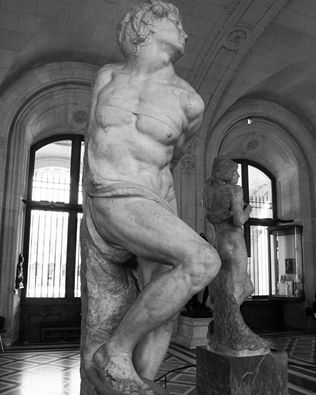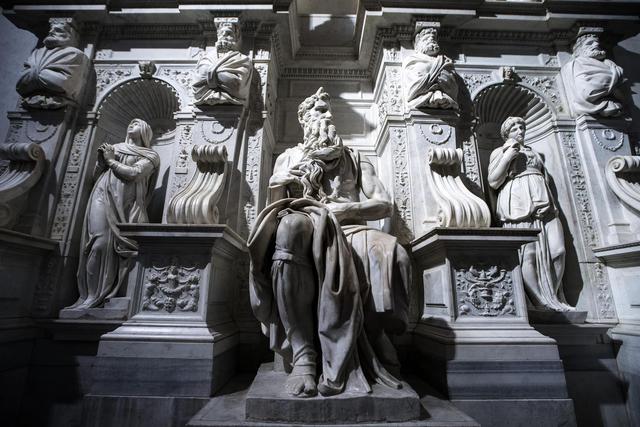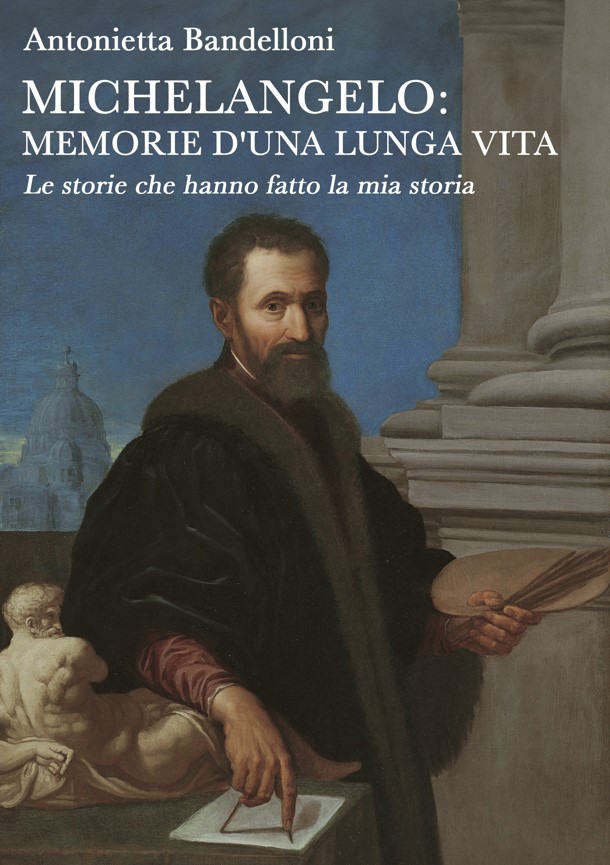La tragedia della mia vita
Papa Giulio II della Rovere, affetto da una smisurata mania di grandezza, mi commissionò la realizzazione del suo monumento funebre. La sua megalomania era pane per i miei denti e mi misi subito al lavoro. Creai per lui un progetto così complesso e grande che avrei dovuto impiegare tutto il resto della mia vita per portarlo a compimento. Il papa, data la sua modestia latente, avrebbe voluto posizionarlo sopra la Tomba di San Pietro, nella basilica ancora in costruzione ovvero dove oggi si c’è l’Altare Maggiore. Giulio II era un personaggio molto particolare che non fu certo noto per la sua umiltà ne’ per la gentilezza d’animo.
Il compenso pattuito fu di 10.000 ducati di Camera. Mi venne data dal pontefice anche una casa-laboratorio dietro Santa Caterina, vicino al cantiere di San Pietro, presso il passo che conduceva direttamente al palazzo pontificio.
Il primo progetto sembrava direttamente ispirato alla fastosità dei sepolcri degli imperatori romani e aveva una forma piramidale e si sviluppava su tre differenti livelli. Comprendeva quaranta sculture in marmo di Carrara e rilievi in bronzo. Nella pianta di 77 metri quadrati avrei inserito il sarcofago con il corpo del pontefice passato a miglior vita.
Il livello inferiore avrebbe dovuto accogliere le Vittorie alternate ai Prigioni stretti nei legacci mentre il secondo livello era quello destinato a Mosè, San Paolo, la Vita Attiva e la Vita Contemplativa.
Infine, nella parte superiore, sarebbe stata collocata la scultura di Giulio II seduto su un trono, sostenuto da due angeli e affiancato dall’allegoria del Cielo e da quella della Terra. La Terra avrebbe pianto per la sua perdita mentre il Cielo avrebbe avuto un aspetto allegro e compiaciuto per aver accolto il Pontefice.
“La tragedia della mia vita”: così definii l’ambizioso complesso scultoreo. Portai avanti la sua realizzazione per quarant’anni con innumerevoli interruzioni a causa di altre commissioni affidatemi alle quali non mi potevo sottrarre in alcun modo. Il progetto originale subì un gran numero di modifiche anche perché Giulio II morì per raggiunti limiti d’età e i successori non avevano certo voglia di sborsare tutti quei danari per un complesso celebrativo di un papa oramai defunto e nemmeno troppo amato.
Il sempre vostro Michelangelo Buonarroti, con i suoi racconti e i suoi lavori lasciati a metà.

The tragedy of my life
Pope Julius II della Rovere, suffering from a huge mania of greatness, commissioned me to make his funeral monument. His megalomania was bread for my teeth and I immediately went to work. I created for him such a complex and large project that I would have to spend the rest of my life to bring it to completion. The pope, given his latent modesty, would have liked to place it over the Tomb of St. Peter, in the basilica still under construction or where today there is the High Altar. Julius II was a very particular character who was certainly not known for his humility nor for his kindness.
The agreed fee was 10,000 House ducats. I was also given by the Pope a house-laboratory behind Santa Caterina, near the construction site of San Pietro, near the pass that led directly to the papal palace.
The first project seemed directly inspired by the splendor of the sepulchers of the Roman emperors and had a pyramidal shape and developed on three different levels. It included forty Carrara marble sculptures and bronze reliefs. In the 77-square-meter plant I would have inserted the sarcophagus with the body of the pontiff passed to better life.
The lower level should have welcomed the Victories alternating with the Prisons tight in the ties while the second level was that destined for Moses, Saint Paul, Active Life and Contemplative Life.
Finally, in the upper part, the sculpture of Julius II was seated on a throne, supported by two angels and flanked by the allegory of Heaven and that of the Earth. The Earth would have cried for her loss while Heaven would have looked cheerful and pleased for having welcomed the Pope.
“The tragedy of my life”: thus defined the ambitious sculptural complex. I carried out its realization for forty years with innumerable interruptions because of other commissions entrusted to me that I could not escape in any way. The original project underwent a large number of changes also because Julius II died due to age limitations and the successors did not want to shell out all those money for a celebratory complex of a now deceased and not too loved pope.
Your always Michelangelo Buonarroti, with his stories and his works left in half.









1 commento »